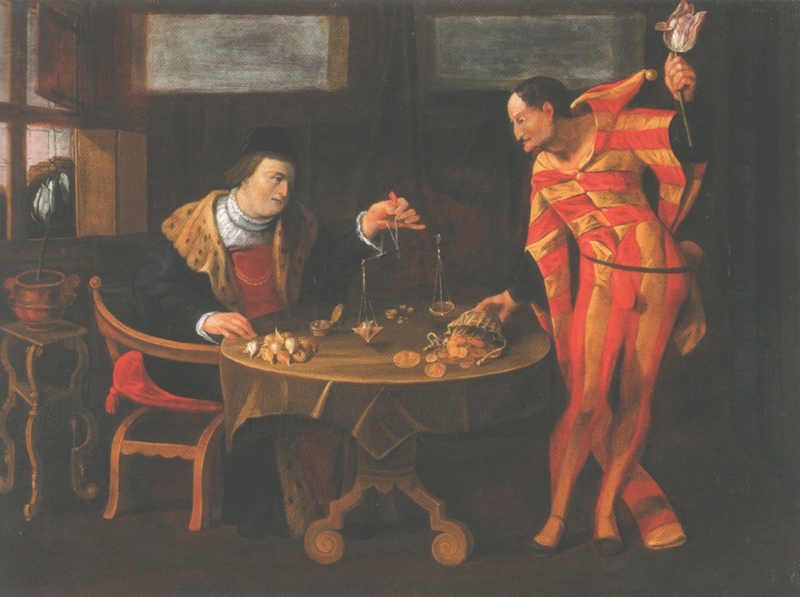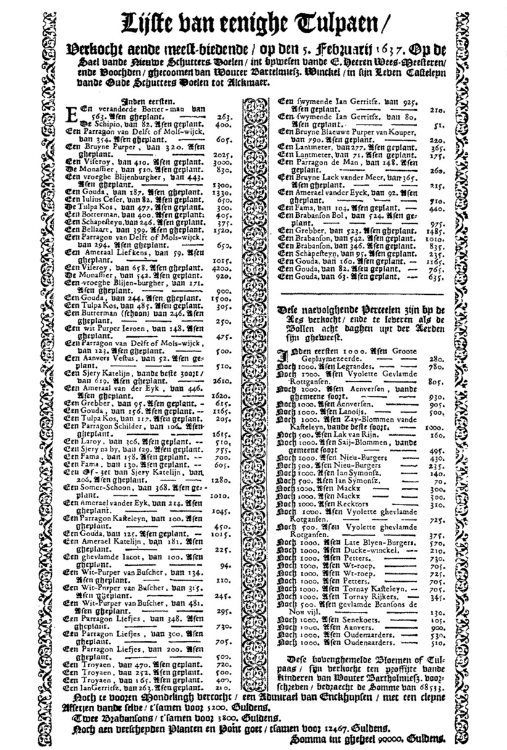"Tulipmania": the stock bubble, which was not

Image: Wikimedia commons
The Smithsonian scientific publication has published material that Dutch Calvinists invented “tulip fever”, which is considered to be the first exchange bubble. People were chasing profits, but not as massively as it is described in textbooks and works of art. And this race certainly did not cause the collapse of the economy and industry. We have prepared a Russian-language adaptation of this article.
')
General madness
When the first tulips were grown in the Middle East, the whole world went insane. Some varieties were worth more than gold. There is a legend that a sailor was accused of a criminal offense and put in prison just because he confused a tuber of a rare tulip with an ordinary onion and ate it for lunch. One bulb of a rare variety, Semper Augustus, with flowers of red and white petals, cost, like a mansion in the fashionable district of Amsterdam, with a personal trainer and a garden to boot. As the cost of the tulip on the market increased, a wave of speculation began - the dealers raised the prices of the bulbs to heaven. And then, as it usually happens with stock market bubbles, the tulip market “burst”, leaving hundreds of sellers without revenue.

Dynamics of futures index (green) and option (red) bulb prices in the years 1635-1637 according to Thompson. Image: Wikimedia Commons
For several decades, economists have put the story of "tulip mania" as an example of the danger and instability of the free market. Writers and historians have written hundreds of books about the absurdity of events. They even made a film on this topic, it is called “ Tulip Fever ”, its plot is based on the book by Deborah Moggsch.
There is only a small nuance: this story is not true.
To understand the truth, you need to understand the history
What actually happened and how did it happen that the history of tulip speculation in Holland was so distorted? Ann Goldgar, a professor of early modern history at King’s College London, discovered the truth when she studied the archives to create the book Tulipmania: Money, Honor and Knowledge in Holland of the Golden Age.
“I always joke that the book should be called“ Tulip amania: it’s duller than you think, ”Goldgar says,“ people like this legend, because they think they can learn a lesson from it. I think this opinion is wrong. ”
Before putting the “tulip fever” on a par with the bubble of the South Sea, which happened in England in the 1700s, with the 19th century railway bubble, with dotcom and bitcoin bubbles, you should study several arguments of Professor Goldgara and understand what was happening in the Dutch Society at the turn of the XVII century.
It is worth starting with the fact that the country experienced a major demographic shift during the war of independence with Spain. During this period, merchants arrived in major port cities: Amsterdam, Harlem, Delft, and began trading, including the famous Dutch East India Company. This brought a huge income Holland, even despite the martial law in the country. At the head of the new independent nation was the urban oligarchy, consisting of rich merchants, unlike other European countries of that era, which were controlled by the nobility. As a result, new faces, ideas and money helped revolutionize the Dutch economy in the late 16th century.
As the economy changed, social interactions and cultural values changed. The growing interest in natural history and the love of exotic among merchants caused a rise in prices for goods from the east, including from the Ottoman Empire. People of all social classes had to develop in new directions, which appeared with the influx of new products. For example, the fish auctioneer created the manuscript “The Book of Whales” and this work allowed him to meet with the president of Holland. Dutch botanist Clusius created a botanical garden at the University of Leiden in 1590 and the tulip quickly rose to its place of honor.
“Wild tulips found in the valleys of the Tien Shan began to be planted in Istanbul in 1055, and in the 15th century they became symbols of the Ottomans. For example, Sultan Mehmed II had 12 gardens with tulips, the maintenance of which required 920 gardeners, ”writes Anna Pavord, a correspondent for gardening in the Internet publication The Independent, in his book“ Tulips ”.
The Dutch have deduced that tulips can be grown from seeds and shoots of the mother bulb. For an onion to grow from a seed and a flower to bloom, it takes from 7 to 12 years. And already ripe onion can become a tulip in a year. Of particular interest to the botanist Clusius and the "tulip speculators" were the "broken bulbs". The petals of the tulips, which grew out of these bulbs, were not monophonic, but multicolored. It was impossible to predict what the future flower would look like. Naturalists invented ways to reproduce such bulbs and buds, as the demand for this rare species was constantly growing. As it turned out later, this effect was due to the fact that the bulbs hurt. They were frail and rarely gave flowers.
“The high market value of tulips, which authors write about“ tulipmania ”write about, was caused by prices for particularly beautiful“ broken bulbs, ”wrote economist Peter Garber,“ because it was impossible to predict what a flower would look like that sprouted from such a bulb. ” , “Tulipmania” can be described as a game of chance among producers who wanted to grow buds in an increasingly unusual coloring. ”

The printed report on the results of the auction in Alkmaar on February 5, 1637. Image: Wikimedia commons
Dutch speculators spent all the money on the bulbs, and then grew flowers, among which, perhaps, only one will bring profit. “As luxuries, tulips fit well into the culture of big capital and new cosmopolitanism,” writes Goldgar. Tulips demanded expertise, experience in evaluating beauty and exotic and, of course, big money.
Beginning of the legend
Here is where the myth comes into play. According to popular legend, “tulipmania” covered all levels of Dutch society in 1630. “The desire of the Dutch to possess rare bulbs was so great that the usual industry was abandoned, and the population, down to the lowest strata, began to sell tulips,” writes Scottish journalist Charles Mackay in the popular work of 1841 “Extremely Popular Errors and Crowd Madness.” According to this work, everyone, from the richest merchants to the poorest chimney sweeps, bought up tulip bulbs and resold them at a higher price. Most of the companies selling tulips were at the end of 1636, and in February the market began to burst at the seams. More and more people went bankrupt, hoping to buy the cherished bulbs, and more and more merchants left in debt became bankrupt. At least, it was always considered so.
“In fact, few people were involved in this and the economic consequences were not so significant,” Goldgar writes, “I could not find in the archives information about at least one bankrupt. If there really was a massive destruction of the economy, as the myth says, it would not be difficult to find the data. ”
These arguments do not mean that everything in the history of "tulip mania" is fiction. The merchants did participate in the frantic tulip trade and paid inconceivable money for a few bulbs. And when buyers could not pay the dealers as much as they had promised in advance, the market collapsed and caused a small crisis. But only because it undermined social expectations.
“In this case, the difficulty lies in the fact that almost all market relations were built on trust. Buyers promised to buy the bulbs from merchants, and then they said, “I don't care that I promised to buy it. Now I don’t need this product. ” The courts did not want to interfere with this and therefore there was no one to make people pay for the goods, ”says Goldgar.
But "tulipmania" did not affect all sectors of society and did not cause the collapse of industry. “The lack of bankruptcy data does not allow a firm conclusion to be drawn, but the results of the study suggest that the speculation with tulip bulbs was not so massive and crazy as is commonly believed,” writes economist Peter Garber.
Who spread the myth?
If “tulipmania” was not such a disaster, why was it put in this light? It can be assumed that offended Christian moralists are to blame for this. With great wealth comes a wave of social unrest. “An incredible level of success has turned their heads. All the incredible stories confirming the economic devastation: about the sailor who was thrown into prison and about the chimney sweeps trying to get rich, came from propaganda brochures. They were spread by Dutch Calvinists, who feared that the tulip boom would lead to social decay. Their conviction that this wealth was terrible has come to our day, ”writes historian Simon Sham, in the book“ Confusion of Wealth: An Interpretation of Dutch Culture in the Golden Age. ”
“Some ideas are ineradicable, for example, one that God does not like cunning and sends plague on them. That's what people could say in 1630, says Ann Goldgar, the idea that cunning is a sin that has survived to modern society. Pride precedes the fall. "
Goldgar does not condemn directors and writers for misinterpreting the past. She is dissatisfied with the incorrect conclusions of historians and economists, who made them in their writings, further spreading the idea of "tulipmania". “I had no way of knowing that this story is a lie until I picked up the old archives. It was an unexpected treasure, ”says Goldgar.
Useful links and materials for studying the stock market
- ITinvest educational resources
- Analytics and market reviews
- Top 10 books to understand the stock market device
- Futures, indices and IPOs: how exchanges really work and why they are needed
- Infrastructure of the Russian securities market (brief educational program)
- How-to: robots and brokerage trading system APIs
Source: https://habr.com/ru/post/339018/
All Articles